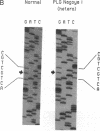Abstract
The gene coding for plasminogen has been compared with several abnormal genes from Japanese patients by the polymerase chain reaction and DNA sequence analysis. Two types of abnormal genes coding for plasminogen were identified in these patients. In the type I mutation, a guanosine in GCT coding for Ala-601 near the active-site histidine was replaced by an adenosine resulting in ACT coding for threonine. This mutation was also shown by the loss of a cleavage site for Fnu4HI endonuclease, a restriction enzyme that recognizes GCTGC but not ACTGC. In the type II mutation, a guanosine in GTC coding for Val-355 was replaced by a thymidine resulting in TTC coding for phenylalanine. This change was readily shown by digestion with Ava II endonuclease, a restriction enzyme that recognizes GGTCC and not GTTCC. The type I mutation has been found to be identical to a plasminogen variant identified in Japanese patients by amino acid sequence analysis and also detected by isoelectric focusing, whereas the type II mutation is a unique amino acid substitution in the connecting region between the third and fourth kringles in plasminogen. DNA sequence analysis also revealed that the abnormal genes carry several silent nucleotide substitutions located primarily within introns and 5' and 3' flanking regions.
Full text
PDF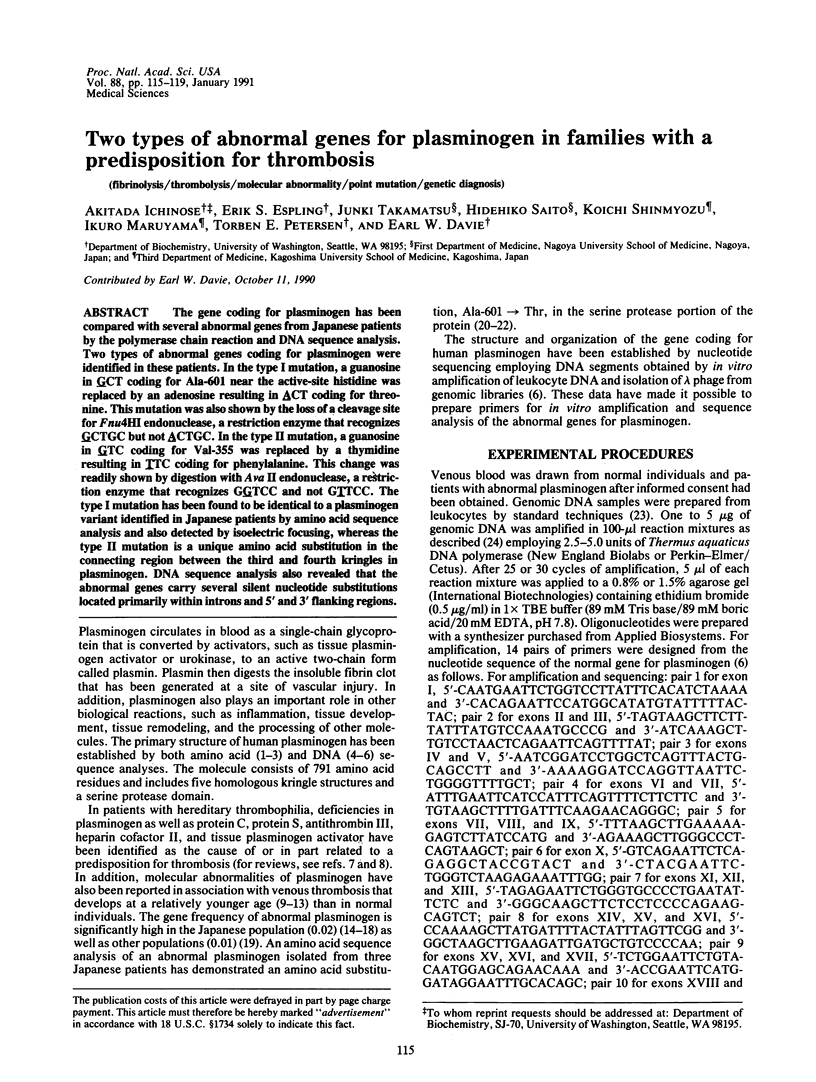
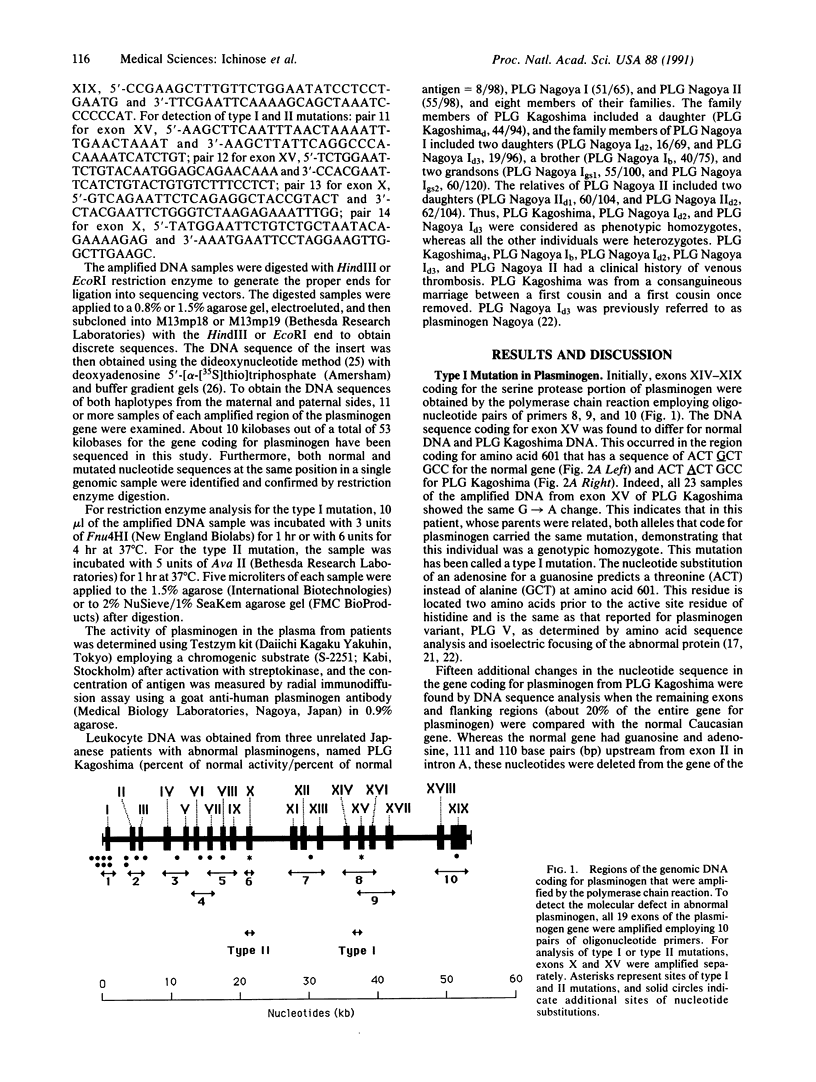
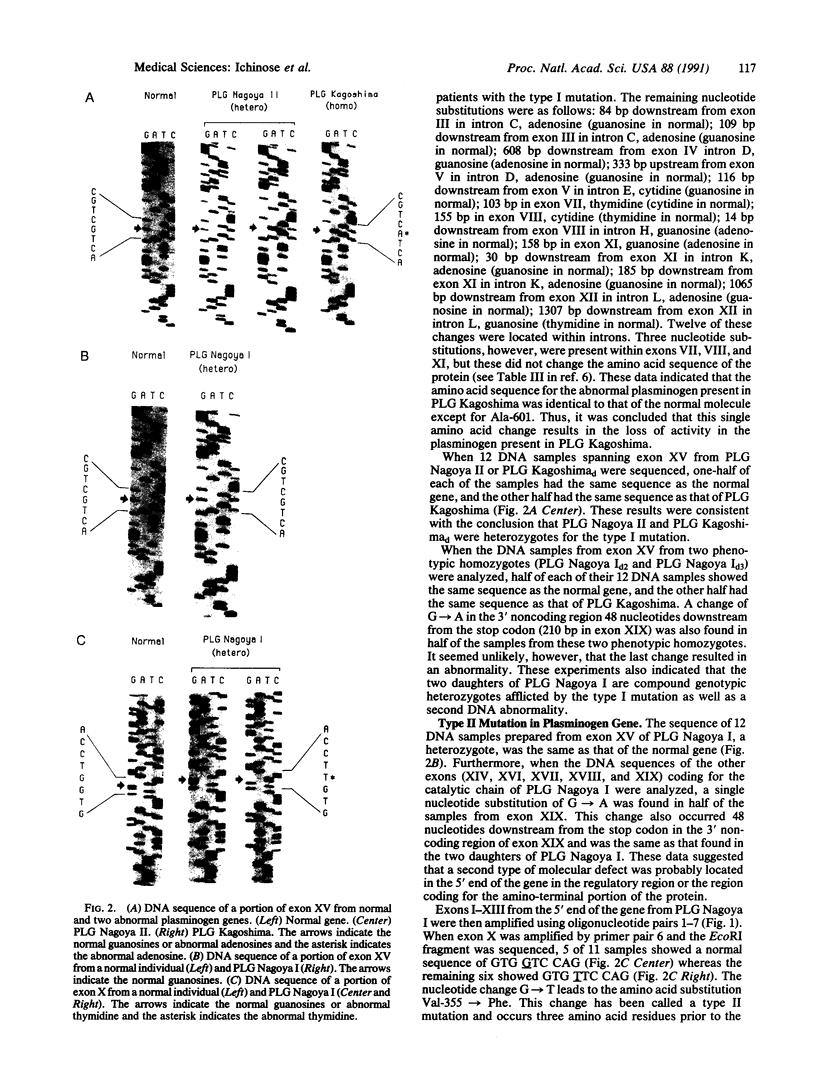
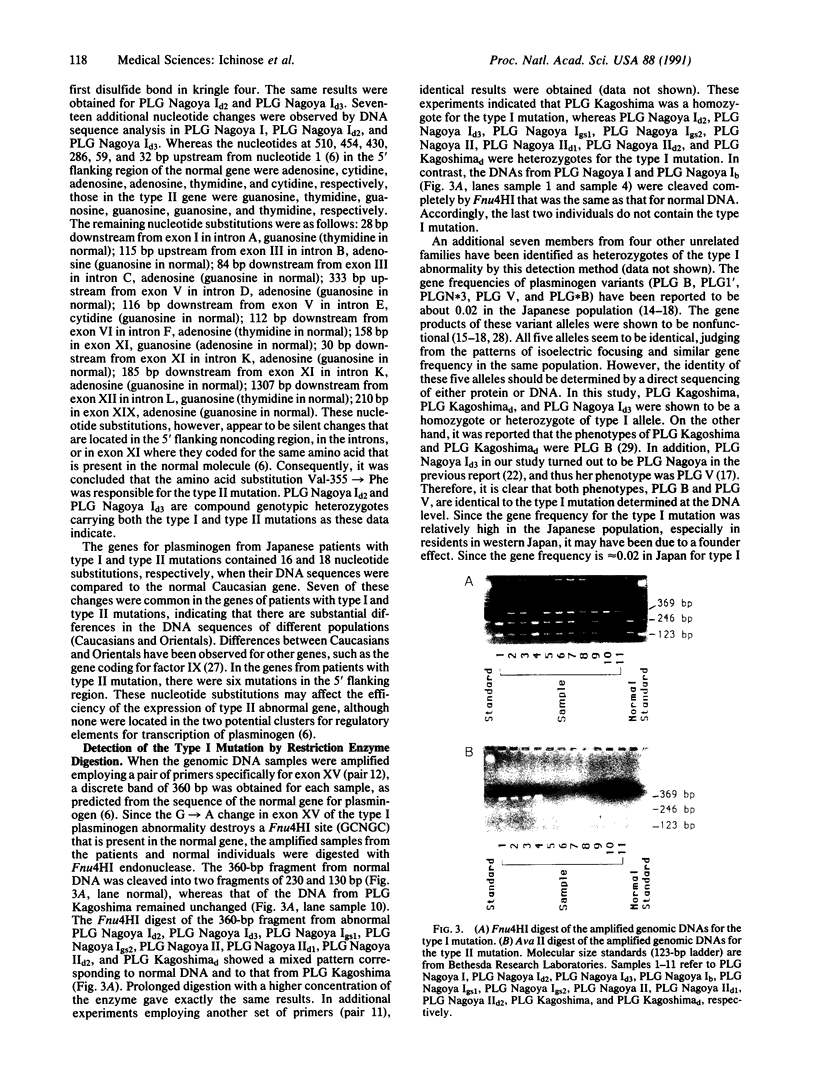
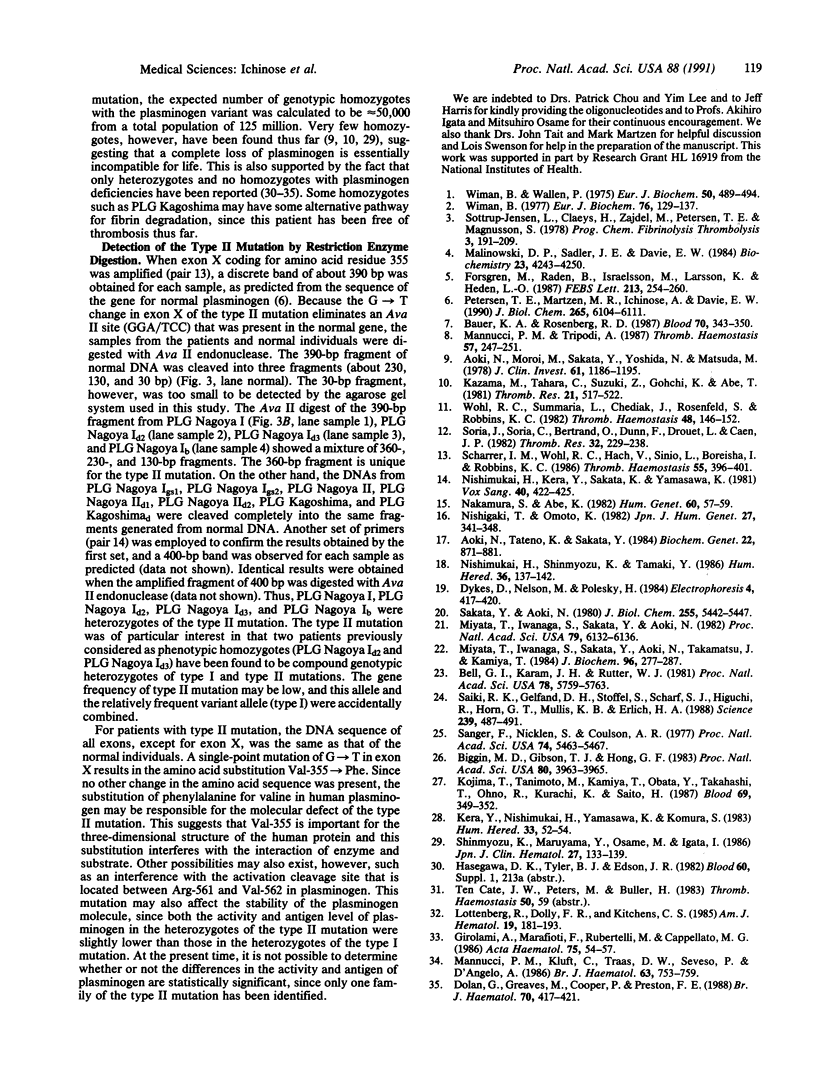
Images in this article
Selected References
These references are in PubMed. This may not be the complete list of references from this article.
- Aoki N., Moroi M., Sakata Y., Yoshida N., Matsuda M. Abnormal plasminogen. A hereditary molecular abnormality found in a patient with recurrent thrombosis. J Clin Invest. 1978 May;61(5):1186–1195. doi: 10.1172/JCI109034. [DOI] [PMC free article] [PubMed] [Google Scholar]
- Aoki N., Tateno K., Sakata Y. Differences of frequency distributions of plasminogen phenotypes between Japanese and American populations: new methods for the detection of plasminogen variants. Biochem Genet. 1984 Oct;22(9-10):871–881. doi: 10.1007/BF00499478. [DOI] [PubMed] [Google Scholar]
- Bauer K. A., Rosenberg R. D. The pathophysiology of the prethrombotic state in humans: insights gained from studies using markers of hemostatic system activation. Blood. 1987 Aug;70(2):343–350. [PubMed] [Google Scholar]
- Bell G. I., Karam J. H., Rutter W. J. Polymorphic DNA region adjacent to the 5' end of the human insulin gene. Proc Natl Acad Sci U S A. 1981 Sep;78(9):5759–5763. doi: 10.1073/pnas.78.9.5759. [DOI] [PMC free article] [PubMed] [Google Scholar]
- Biggin M. D., Gibson T. J., Hong G. F. Buffer gradient gels and 35S label as an aid to rapid DNA sequence determination. Proc Natl Acad Sci U S A. 1983 Jul;80(13):3963–3965. doi: 10.1073/pnas.80.13.3963. [DOI] [PMC free article] [PubMed] [Google Scholar]
- Dolan G., Greaves M., Cooper P., Preston F. E. Thrombovascular disease and familial plasminogen deficiency: a report of three kindreds. Br J Haematol. 1988 Dec;70(4):417–421. doi: 10.1111/j.1365-2141.1988.tb02510.x. [DOI] [PubMed] [Google Scholar]
- Forsgren M., Råden B., Israelsson M., Larsson K., Hedén L. O. Molecular cloning and characterization of a full-length cDNA clone for human plasminogen. FEBS Lett. 1987 Mar 23;213(2):254–260. doi: 10.1016/0014-5793(87)81501-6. [DOI] [PubMed] [Google Scholar]
- Girolami A., Marafioti F., Rubertelli M., Cappellato M. G. Congenital heterozygous plasminogen deficiency associated with a severe thrombotic tendency. Acta Haematol. 1986;75(1):54–57. doi: 10.1159/000206083. [DOI] [PubMed] [Google Scholar]
- Kazama M., Tahara C., Suzuki Z., Gohchi K., Abe T. Abnormal plasminogen, a case of recurrent thrombosis. 1981 Feb 15-Mar 1Thromb Res. 21(4-5):517–522. doi: 10.1016/0049-3848(81)90154-7. [DOI] [PubMed] [Google Scholar]
- Kera Y., Nishimukai H., Yamasawa K., Komura S. Comparative study of phenotypes on activity and plasma concentration in the genetic system of plasminogen. Hum Hered. 1983;33(1):52–54. doi: 10.1159/000153347. [DOI] [PubMed] [Google Scholar]
- Kojima T., Tanimoto M., Kamiya T., Obata Y., Takahashi T., Ohno R., Kurachi K., Saito H. Possible absence of common polymorphisms in coagulation factor IX gene in Japanese subjects. Blood. 1987 Jan;69(1):349–352. [PubMed] [Google Scholar]
- Lottenberg R., Dolly F. R., Kitchens C. S. Recurring thromboembolic disease and pulmonary hypertension associated with severe hypoplasminogenemia. Am J Hematol. 1985 Jun;19(2):181–193. doi: 10.1002/ajh.2830190211. [DOI] [PubMed] [Google Scholar]
- Malinowski D. P., Sadler J. E., Davie E. W. Characterization of a complementary deoxyribonucleic acid coding for human and bovine plasminogen. Biochemistry. 1984 Aug 28;23(18):4243–4250. doi: 10.1021/bi00313a035. [DOI] [PubMed] [Google Scholar]
- Mannucci P. M., Kluft C., Traas D. W., Seveso P., D'Angelo A. Congenital plasminogen deficiency associated with venous thromboembolism: therapeutic trial with stanozolol. Br J Haematol. 1986 Aug;63(4):753–759. doi: 10.1111/j.1365-2141.1986.tb07559.x. [DOI] [PubMed] [Google Scholar]
- Mannucci P. M., Tripodi A. Laboratory screening of inherited thrombotic syndromes. Thromb Haemost. 1987 Jun 3;57(3):247–251. [PubMed] [Google Scholar]
- Miyata T., Iwanaga S., Sakata Y., Aoki N. Plasminogen Tochigi: inactive plasmin resulting from replacement of alanine-600 by threonine in the active site. Proc Natl Acad Sci U S A. 1982 Oct;79(20):6132–6136. doi: 10.1073/pnas.79.20.6132. [DOI] [PMC free article] [PubMed] [Google Scholar]
- Miyata T., Iwanaga S., Sakata Y., Aoki N., Takamatsu J., Kamiya T. Plasminogens Tochigi II and Nagoya: two additional molecular defects with Ala-600----Thr replacement found in plasmin light chain variants. J Biochem. 1984 Aug;96(2):277–287. doi: 10.1093/oxfordjournals.jbchem.a134836. [DOI] [PubMed] [Google Scholar]
- Nakamura S., Abe K. Genetic polymorphism of human plasminogen in the Japanese population: new plasminogen variants and relationship between plasminogen phenotypes and their biological activities. Hum Genet. 1982;60(1):57–59. doi: 10.1007/BF00281264. [DOI] [PubMed] [Google Scholar]
- Nishigaki T., Omoto K. Genetic polymorphism of human plasminogen in Japanese: correspondence of alleles thus far reported in Japanese and difference of activity among phenotypes. Jinrui Idengaku Zasshi. 1982 Dec;27(4):341–348. doi: 10.1007/BF01900446. [DOI] [PubMed] [Google Scholar]
- Nishimukai H., Kera Y., Sakata K., Yamasawa K. Genetic polymorphism of plasminogen: a new basic variant (PLG B) and population study in Japanese. Vox Sang. 1981;40(6):422–425. doi: 10.1111/j.1423-0410.1981.tb00731.x. [DOI] [PubMed] [Google Scholar]
- Nishimukai H., Shinmyozu K., Tamaki Y. Polymorphism of plasminogen in healthy individuals and patients with cerebral infarction. Hum Hered. 1986;36(3):137–142. doi: 10.1159/000153617. [DOI] [PubMed] [Google Scholar]
- Petersen T. E., Martzen M. R., Ichinose A., Davie E. W. Characterization of the gene for human plasminogen, a key proenzyme in the fibrinolytic system. J Biol Chem. 1990 Apr 15;265(11):6104–6111. [PubMed] [Google Scholar]
- Saiki R. K., Gelfand D. H., Stoffel S., Scharf S. J., Higuchi R., Horn G. T., Mullis K. B., Erlich H. A. Primer-directed enzymatic amplification of DNA with a thermostable DNA polymerase. Science. 1988 Jan 29;239(4839):487–491. doi: 10.1126/science.2448875. [DOI] [PubMed] [Google Scholar]
- Sakata Y., Aoki N. Molecular abnormality of plasminogen. J Biol Chem. 1980 Jun 10;255(11):5442–5447. [PubMed] [Google Scholar]
- Sanger F., Nicklen S., Coulson A. R. DNA sequencing with chain-terminating inhibitors. Proc Natl Acad Sci U S A. 1977 Dec;74(12):5463–5467. doi: 10.1073/pnas.74.12.5463. [DOI] [PMC free article] [PubMed] [Google Scholar]
- Scharrer I. M., Wohl R. C., Hach V., Sinio L., Boreisha I., Robbins K. C. Investigation of a congenital abnormal plasminogen, Frankfurt I, and its relationship to thrombosis. Thromb Haemost. 1986 Jun 30;55(3):396–401. [PubMed] [Google Scholar]
- Shinmyozu K., Maruyama Y., Osame M., Igata A. [Blood coagulation studies in a family with congenital plasminogen abnormality--with a special relevance to the association of thrombotic tendency with abnormal plasminogen]. Rinsho Ketsueki. 1986 Feb;27(2):133–139. [PubMed] [Google Scholar]
- Soria J., Soria C., Bertrand O., Dunn F., Drouet L., Caen J. P. Plasminogen Paris I: congenital abnormal plasminogen and its incidence in thrombosis. Thromb Res. 1983 Oct 15;32(2):229–238. doi: 10.1016/0049-3848(83)90034-8. [DOI] [PubMed] [Google Scholar]
- Wiman B. Primary structure of the B-chain of human plasmin. Eur J Biochem. 1977 Jun 1;76(1):129–137. doi: 10.1111/j.1432-1033.1977.tb11578.x. [DOI] [PubMed] [Google Scholar]
- Wiman B., Wallén P. Structural relationship between "glutamic acid" and "lysine" forms of human plasminogen and their interaction with the NH2-terminal activation peptide as studied by affinity chromatography. Eur J Biochem. 1975 Jan 15;50(3):489–494. doi: 10.1111/j.1432-1033.1975.tb09887.x. [DOI] [PubMed] [Google Scholar]
- Wohl R. C., Summaria L., Chediak J., Rosenfeld S., Robbins K. C. Human plasminogen variant Chicago III. Thromb Haemost. 1982 Oct 29;48(2):146–152. [PubMed] [Google Scholar]




